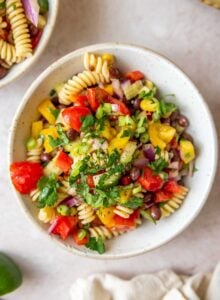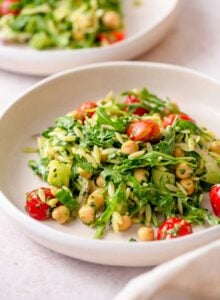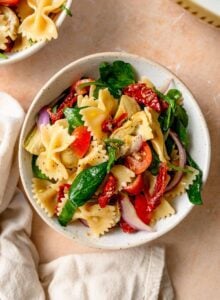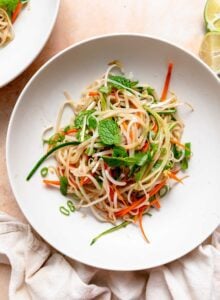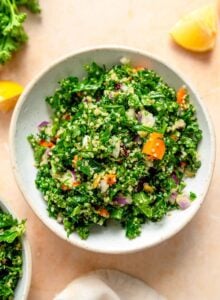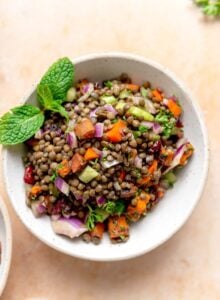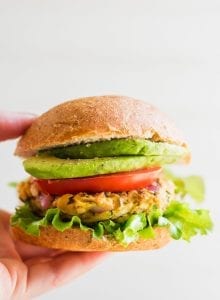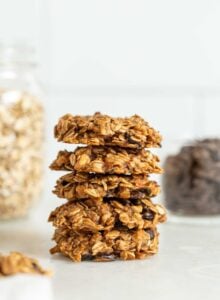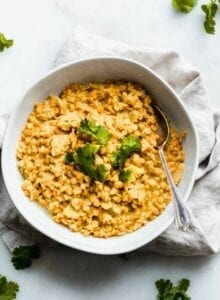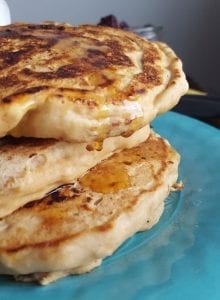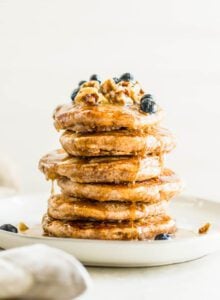Flexible Dieting FAQ
This article covers frequently asked questions about flexible dieting for vegans and plant-based athletes.
How accurate do I need to be?
It’s generally recommend that you stat within 5 grams plus or minus for protein and carbs, and within 2 grams, plus or minus for fat. I rarely hit my macros spot on but I do try to stay fairly close. I aim for plus or minus 10 grams on protein and carbs, and 5 grams on fats, while staying within my daily calories.
So if my goal was to eat 200 grams of carbohydrates, I aim to stay within 190-210 grams. I’m not worried about a change of 40 calories in either direction. I’m not trying to make a weigh class or hit the stage in a figure competition. Since fat contains more calories per gram than carbohydrates and protein, I try to say within 5 grams of my goals.
The more accurate and diligent you are the better but it’s a personal decision as to how precise yo’d like to be. There’s always a trade off. If you’re a bit more relaxed, results will be slower so unless you’re as accurate as possible, no complaining about slow results. Always aim for consistency, not perfection. By giving yourself a bit of leeway, you’ll allow for some more flexibility day to day and take out the stress of hitting your macros on the nose.
Don’t worry if you’re not 100% accurate, it will not make or break your results.
How do you do vegan macros?
First, read through my best vegan protein sources post. I would also recommend reading my vegan nutrition guide. Next, it’s important to include higher protein plant-based foods in every meal and snack throughout the day. I prefer not to rely on protein powder so I get it through whole food sources such as beans, lentils, tofu, tempeh, nuts, seeds and the highest protein whole grains and vegetables.
I typically use one serving of a whole food protein powder daily, added to a smoothie or oats, and then I get the rest of my protein from whole foods. I don’t eat a super high protein diet and I eat adequate fat and carbs to support my activity level and track macros in a low-stress and sustainable way. Currently, about 20% of my calories come from protein, which is easily achievable through whole foods.
I would recommend adjusting your ratio to include slightly higher fat and carb than would typically be recommended for a traditional “IIFYM” numbers. This will allow you to easily hit your protein number without the need for excessive amounts of protein powders, seitan, soy and processed foods.
Here’s a sample daily meal plan consisting of approximately 2200 calories with 110 grams of plant-based protein:
UPON RISING 4:30 AM
First thing when I get up in the morning, I drink 1 L of water with lemon and apple cider vinegar. This helps me re-hydrate after sleeping all night and wakes up the digestive system. At this time I also take my supplements. After I drink my water, I’ll make some tea or coffee and prepare a pre-workout snack.
PRE-WORKOUT SNACK
Acorn Squash: baked acorn squash topped with peanut butter and hemp seeds.
BREAKFAST (POST-WORKOUT)
Oatmeal: oats cooked with chia seeds, vegan protein powder and blueberries then topped with almond butter
Other options: Vegan Sweet Potato Breakfast Burritos, Breakfast Burrito Bowls, Chocolate Chip Zucchini Overnight Oats, Strawberry Cheesecake Overnight Protein Oats, Grain-Free Coconut Chia Breakfast Bowls, Vegan Chickpea Flour Pancakes, Superfood Chocolate Almond Avocado Smoothie, Vegan Peaches and Cream Oatmeal, Vegan Peanut Butter Blueberry Oats
SNACK
Smoothie bowl: frozen peach, spinach, celery, moringa powder, spirulina powder, zucchini and vegan protein powder. Blend with water until smooth then top with hemp seeds, ground flax seed and chopped walnuts.
LUNCH
Buddha Bowl: base of massaged kale, marinated chickpeas, baked tofu, steamed broccoli, grated carrots, grated beets, sunflower seeds, tahini sauce.
Other options: Vegan Roasted Beet Salad with Marinated Chickpeas, Spicy Vegan Black Bean Soup, Creamy Cauliflower Wild Rice Soup, Roasted Squash Salad with Marinated Chickpeas, Red Lentil Tomato Soup
SNACK
Smoked Tofu on Rice Cakes: sliced smoked tofu on thin brown rice cakes with cucumber and cashew cream cheese, sprinkled with hemp seeds
Handful of Raw Mixed Nuts
DINNER
Zucchini Noodle Pasta: spralized zucchini noodles, topped with homemade mushroom, carrot, onion, garlic tomato pasta sauce, fresh basil and vegan parmesan.
Other options: Vegan Chickpea Quinoa Stew, Coconut Red Lentil Dahl, 6-Ingredient Easy Cheesy Vegan Zoodles, Spicy Peanut Stew with Rice and Chickpeas, Sweet Potato Peanut Stew, Wild Rice and Broccoli Salad with Edamame, Broccoli Brown Rice Bowl with Almond Satay Sauce
Do I have to track vegetables?
Yes and no, and it’s up to you. I track all starchy vegetables like sweet potatoes, potato and corn. I also track all non-starchy vegetables but I’m not super accurate with them and sometimes I don’t even bother. A big handful of greens is so low in calories that for my purposes, it’s negligible.
I do like adding in all my veggies so I can track micronutrients though. This helps me keep an eye on my vitamins and fibre intake. When in doubt, track everything but don’t worry too much about accuracy with non-starchy vegetables. I do however, recommend eating them at every meal to help keep you full and ensure you’re consuming plenty of fibre, vitamins, minerals and other important micronutrients.
How do I get started?
Read this post on How to Get Started with Flexible Dieting for a full run down on what you’ll need to start your macro journey.
Can’t I just count calories?
Of course you could. Counting calories to create a deficit or surplus will allow gradual weight loss or gain, respectively. Tracking macros is just a more accurate way to count calories and customize your nutrition plan based on performance and body composition goals, as well as fitness preferences.
Tracking macros can also help you focus on eating a whole food, balanced diet instead of just filling your diet with nutrient-poor calories that might not be providing you with the micronutrients you need to be healthy.
How do I calculate my macros?
I like the calculator IIFYM.com to calculate my macros. Depending on your goals, you can either set it to Performance, Fat Loss of Muscle Gain. You can also adjust how aggressive you want to be in either direction. If you’re just starting out I would recommend using your TDEE macros for a couple of weeks to get the hang of tracking and starting getting some consistency.
See what your weight does and how you feel and adjust from there. If you’re goals include fat loss, I would start conservatively moving towards a calorie deficit through a reduction in carbs and fats. You can use the calculator to come up with all those umbers.
I can’t stress enough that there are no “magic macros” so don’t worry too much about the exact numbers. Get some numbers for a starting point and be consistent with them for at least a couple weeks, if not months, before changing anything.
I get so many questions about what macros to use and what macros I use specifically. I have the same answer to this question over and over: the exact numbers just aren’t that important. Calories in vs. out will be the biggest determining factor of your results and there are a lot of other factors that calculators do not account for.
Just set some numbers, get started and be consistent. There’s no need to worry so much about exact numbers. Consistency over time is what you should focus on.
Do I have to eat low carb?
Nope. And I actually don’t suggest it for athletes. We need carbs to train, recover and make those gains! I would suggest a moderate carbohydrate intake of about 40-50% of your total calories but this will vary per individual. That being said, some people may do better with a lower carb and higher fat diet. That’s something you have to play around with and see what works best for you. I wouldn’t recommend following diet trends or exactly what someone else is doing. We are all so unique in our nutritional needs.
Focus on getting carbs from nutrient-rich carbohydrates such as sweet potatoes, whole grains such as oatmeal, quinoa and whole grain bread, fruit and plenty of vegetables. You can also time your carbs around your workouts to make the most of them for energy and recovery.
What are vegan sources of fats?
Plant-based fats are the best kind of fats! Think:
- avocado
- nuts
- seeds
- nut and seed butters
- MCT oil
- avocado oil
- coconut oil
- extra-virgin olive oil
- any coconut products
Ideally you’ll get most of your fats from whole foods rather than oils but if you do use them on occasion, healthier oils include extra virgin olive oil, avocado oil, walnut oil, hemp oil, flax oil, coconut oil and MCT oil.
What macro ratio should I use?
Again, there is no magic macro ratio to reach your goals. Hard work, patience and consistency is the only way. If it was easy, everyone would do it and no one would be overweight. The fact of the matter is, it’s not always easy but if you roll your sleeves, get disciplined and trust the process, you will absolutely get where you want to be.
If you’re highly active and looking to build or retain muscle mass while reducing body fat, I’d recommend keeping protein somewhere between 0.5-65 gram per pound of body weight, carbs around 40-50% of your calories and the rest of your calories coming from fat. That’s a big variance, so just pick some starting numbers recommended by the calculator and be consistent with them. Take note how you feel, monitor your weight and progress photos and then you slowly start to adjust based on your own goals and preferences.
Please note, I am not a doctor or nutrition professional and am only speaking from personal experience.
Do I have to track supplements?
Yes and no.
Sports supplements like BCAA is a source of protein and should be tracked accordingly. Multivitamins and other nutritional supplements do not need to be tracked. Some superfood powders, protein powders and some pre-workouts should be tracked. When in doubt, read the nutrition facts and scan it into My Fitness Pal to compare. You can also look online to confirm the My Fitness Pal entry. If you use an omega-3 supplement, don’t forget to track the fat in that.
Again, it depends on your goals and how rigid and strict you want to be.
What if I hit my macros in My Fitness Pal but still have calories left over?
Always go by the macros.
My Fitness Pal relies on user generate entires and they may not always be 100% accurate. This is why it’s important to always double check the entry you use if something doesn’t sound right. In the real word, it’s impossible to hit your macros but still have calories left. Carbohydrates and protein contain 4 calories per gram and fat contains 9, so whatever macros you eat will determine how many calories you’ve consumed. The error is in the tracking app, so go by the macronutrient number and don’t worry about the calories.
Is premium version of My Fitness Pal worth it?
I have found the premium version to be worth it. I find the ads in the free version to be really annoying plus I like the ability to set my macros exactly and set different macros for each day. I also like the option to display the macros I have left at the top of my diary rather than the calories.
Do I measure foods raw or cooked?
Ideally, always measure your food before you cook it. If you are weighing your food once it’s cooked, make sure you use the appropriate entry in My Fitness Pal. For example, “sweet potato, baked in skin” versus “sweet potato, raw unprepared.”
Do I have to eat the same thing everyday?
Absolutely not. That’s what’s so amazing about tracking macros. In fact, I encourage you to enjoy some variety and try to eat as many colourful foods as possible. Relying on the exact same foods everyday can certainly make things smoother, especially during a busy week but you can eat any food you want to meet your macronutrient goals and this can be as different or as similar day to day as you choose.
For some ideas on macro-friendly vegan foods, check out these posts:
- Macro Friendly Foods for Vegan Flexible Dieting
- 23 Vegan Flexible Dieting Meal and Snack Ideas
- Vegan IIFYM: Tips and Meal Plans from Week Two
- Vegan Macros: Top Foods for Plant-Based Flexible Dieting
Do I have to meal prep?
Nope. Not if you don’t want to however I find it helpful to have all my meals and macros ready in advance. I food prep a few recipes, wash and chop vegetables and prepare healthy snacks for the week but I don’t prep complete meals.
Some people like to prep 5 days worth of complete meals and I would probably have to do the same if I had a particularly jam-packed week.
It depends how much time you want to spend in the kitchen too and how much you enjoy cooking. I don’t mind preparing some of my food daily since I enjoy cooking but for those days when I just don’t feel like it, it’s so important that I have quick and easy options ready in the fridge.
What if I completely mess up my macros?
No big deal, just move on and start fresh the next day or at the next meal. Most importantly, don’t beat yourself up or stress out. It’s important to have a healthy relationship with food and try to keep perspective on what’s important in life. Improving your health should be a joyful process, not a stressful one.
Obviously if you’re missing your macros day after day, you won’t see results but missing a day or a meal every now and again, isn’t a big deal. Especially if you’re active and healthy.
There’s really no way around it. Changing your body takes time, patience, dedication and hard work. That’s it. No magic pill, no secret formula. Do the work, see the results. You’re the only one that can do it but you have the power to achieve anything you want, if you’re willing to commit to it. Just like anything in life, right!
What are “free foods”?
Free foods are foods that have negligible calories and can be used without the need to track. This includes most spices, condiments like mustard, black coffee and tea, vinegars and hot sauce. I consider fresh herbs, the unsweetened almond milk I put in my coffee and some other very low calorie foods to be “free” as well.
It’s up to you how strict you want to be. Remember, the more accurate your are, the faster you’ll reach your goals but if you choose to be a little more relaxed, be okay with slower results. You have to find a balance between mental health, stress and how strict you want to be with flexible dieting.
How do I get enough protein if I don’t eat meat?
To be honest, guys, it’s going to take some work and some planning and depending on your protein goals, you’re probably going to need protein powder to meet your macro requirements. Aside from using a protein supplement a couple times a day, you’ll need to focus on the highest protein plant foods you can.
Think seitan, tofu, tempeh, beans, nuts, edamame, higher protein grains, hemp seeds, chia seeds and the highest protein vegetables. It can be done and furthermore, we don’t need as much protein as you may think.
There are vegan bodybuilders, Crossfit athletes, endurance competitors and strongmen that are smashing stereotypes and doing it without any animal protein. With some research, a bit of a learning curve and listening to your body, plant-based flexible dieting is totally doable.
More on this in my post on the best vegan protein sources.
What supplements should I take?
I suggest taking at least a B12 and omega-3 supplement. If you’re highly active and eating plant-based, you may want to consider vitamin D, calcium, zinc and magnesium as well but if you eat a balanced, whole food diet and take a good multi, you may already be covered all your bases. If you take an omega-3 supplement, don’t forget to track the fats in it.
Creatine has also been very well studied with positive results for athletes but remember that supplements will make up a very small percentage of your results so don’t worry about it you don’t want to use any or don’t have the budget.
Do I add back in the calories I burn during exercise?
No. This defeats the whole purpose of tracking macros for body composition and performance goals. Plus if you add back in the calories you ate during exercise, you may even end up going into a calorie surplus and eating too much.
My weight jumped up 5 lbs overnight, what do I do??
Nothing. Keep going. Weight fluctuations are totally normal and can be due to many different factors. A particularly tough workout, hydration levels, hormones and more can cause weight fluctuations on a daily basis. This is why it’s important to look at averages over weeks and months and not day to day. My weight has changed as much as 8 lbs in one day. No matter. Just log it and move on! Do not left the scale hold emotional power over you or let it determine your effort. Focus on the process and keep going.
I only weigh myself once or twice a week. I do no suggest weighing yourself every day if you find the number on the scale is affecting the effort you give or your mental state. Weight is also not always the best indicator of progress. Weekly photos can give us a much better idea of changes in body composition over time.
Do I have to do this forever?
The short answer is no, of course not. You can do this for as long or as short as you want. I think tracking macros is just one tool you can keep your back pocket to help maintain a healthy body weight and make changes at certain points in your life.
At this point in my life, I feel like I’ll be tracking in some capacity for the time being. Sometimes I’m diligent and sometimes I take breaks.
Using macro counting has taught me so much about how to fuel my body and how much food I need to eat. I can eyeball pretty efficiently at this point if needed.
I love eating and food, and I definitely eat with my eyes, which can to overeating if I’m not paying attention. I like knowing what I’m eating in day-to-day life from a nutrition standpoint but I’m not super strict. I enjoy 1 or 2 untracked meals per week and I do not track macros on vacations. That works for my lifestyle and goals.
Can I eat at restaurants?
Eating out occasionally can certainly be incorporated into your macro program but if you visit restaurants frequently, it can be difficult to progress. Estimating your macros too often will definitely stall your progress. Some restaurants provide the nutritional information for their menus but it’s not that common. If you can visit one that does, go for it and plan in advance to find something that will fit into your day.
I don’t eat out all that often when I’m tracking macros because it’s just too hard to fit in. You’ll find restaurant meals to often be very high in fat and carbohydrates, sometimes as much as all of your fat in just one meal. That’s not worth it to me. I’d rather cook something at home. When it comes to social time, instead of meeting friends for meals, I now suggest we grab coffee and go for a walk. It’s a win-win for everybody. We save money, get some exercise and get to catch up at the same time.
Some people do go as far as bringing a food scale to a restaurant. I’m not going to do that but I respect that commitment and discipline. If I have a special meal planned, I’ll either estimate it or not track it at all. I don’t go out that much so for me, it’s not a big deal. The most important thing is to really enjoy the treat then just go back to normal the next day. Remember to keep perspective. Life is short and you’ve got to work on finding a balance that works for you.
It depends where you’re at in your macro journey too. If you’re trying to lose fat, I find it’s easier to be more dedicated to a nutrition plan and just get it done. Once you’re where you want to be and maintaining your weight, you can allow for a few more treats and meals out.
Do you have any advice for beginners?
My biggest piece of advice when it comes to flexible dieting is to relax. Seriously, relax. Chances are you’re not a professional athlete in a weight class-based sport, so there’s no need to be tracking broccoli down to the gram.
This is your life we’re talking about and it’s not meant to be spent obsessing over food. Focus on food quality, fuel yourself with nutrient-dense food, ditch the “if it fits my macros” mindset and simply use tracking as a way to better understand the power of food.
You’ve got to get your mind off the results and just focus on the process. Enjoy the work. Fall in love with the quiet discipline of it all. Take full responsibility for your progress. Forget the scale. Focus on one day a time.
Time will pass and before you know it, if you’ve been consistent and focused on the systems and the process, the results of all your hard work will start to show. Get over yourself, put your head down and just keep showing up day after day. Don’t give up and you can’t fail.


